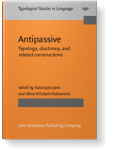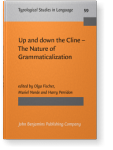Sergey Say
List of John Benjamins publications for which Sergey Say plays a role.
2021 Chapter 6. Antipassive and the lexical meaning of verbs Antipassive: Typology, diachrony, and related constructions, Janic, Katarzyna and Alena Witzlack-Makarevich (eds.), pp. 177–212 | Chapter
Descriptions of antipassive constructions in individual languages show that these constructions are often compatible with only a subset of transitive verbs. There are significant typological similarities between the sets of verbs that allow antipassivization. The following properties are typical… read more
2014 Between predicative and attributive possession in Bashkir On Diversity and Complexity of Languages Spoken in Europe and North and Central Asia, Suihkonen, Pirkko and Lindsay J. Whaley (eds.), pp. 175–202 | Article
Bashkir employs the genitive strategy for predicative possessive construction (‘he has a car’ literally is ‘his car exists’). However, in predicative possessive constructions the genitival possessor shows syntactic properties that are mostly indicative of its clause-level status. Some other uses… read more
2013 On the Nature of Dative Arguments in Russian Constructions with «Predicatives» Current Studies in Slavic Linguistics, Kor Chahine, Irina (ed.), pp. 225–246 | Article
Based on diachronic corpus data, the ability of Russian predicatives (категория состояния, items like холодно ‘it is cold’, грустно ‘it is sad’, приятно ‘it is pleasant’) to co-occur with dative Experiencers is compared to the ability of corresponding adjectives to co-occur with Experiencers. The… read more
2005 Antipassive Sja-Verbs in Russian: Between Inflection and Derivation Morphology and its demarcations: Selected papers from the 11th Morphology meeting, Vienna, February 2004, Dressler, Wolfgang U., Dieter Kastovsky, Oskar E. Pfeiffer and Franz Rainer (eds.), pp. 253–275 | Article
2004 Grammaticalization of word order: Evidence from Lithuanian Up and down the Cline – The Nature of Grammaticalization, Fischer, Olga, Muriel Norde and Harry Perridon (eds.), pp. 363–384 | Article




